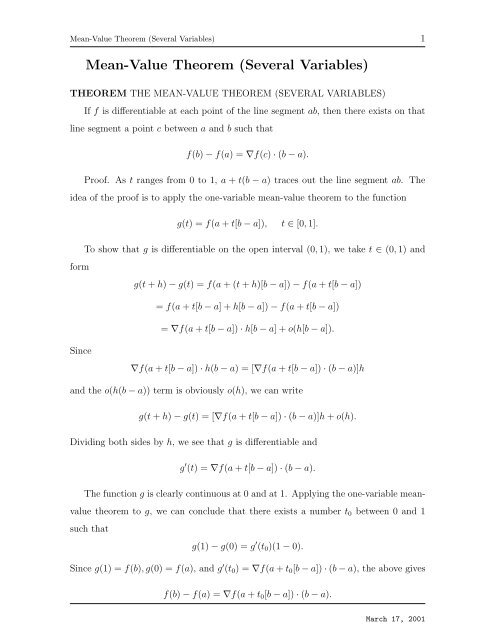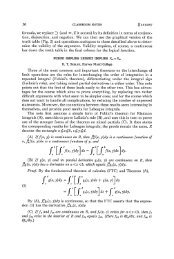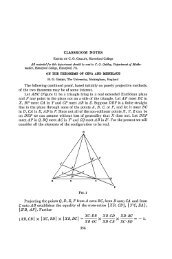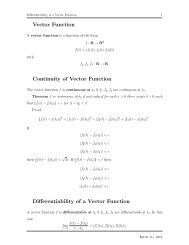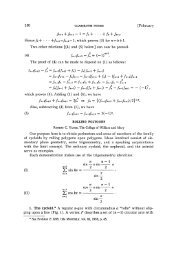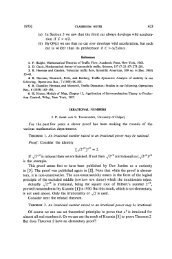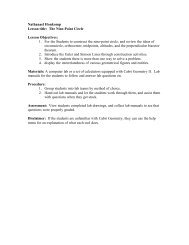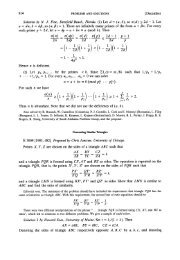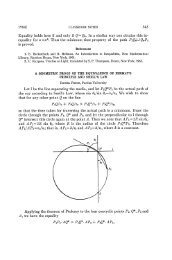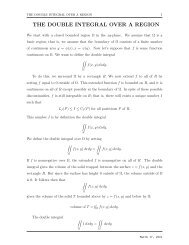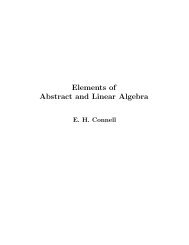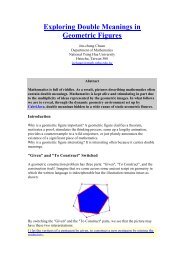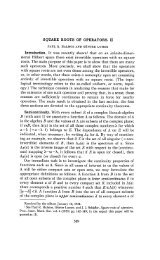Mean-Value Theorem (Several Variables)
Mean-Value Theorem (Several Variables)
Mean-Value Theorem (Several Variables)
You also want an ePaper? Increase the reach of your titles
YUMPU automatically turns print PDFs into web optimized ePapers that Google loves.
<strong>Mean</strong>-<strong>Value</strong> <strong>Theorem</strong> (<strong>Several</strong> <strong>Variables</strong>) 1<br />
<strong>Mean</strong>-<strong>Value</strong> <strong>Theorem</strong> (<strong>Several</strong> <strong>Variables</strong>)<br />
THEOREM THE MEAN-VALUE THEOREM (SEVERAL VARIABLES)<br />
If f is differentiable at each point of the line segment ab, then there exists on that<br />
line segment a point c between a and b such that<br />
f(b) − f(a) = ∇f(c) · (b − a).<br />
Proof. As t ranges from 0 to 1, a + t(b − a) traces out the line segment ab. The<br />
idea of the proof is to apply the one-variable mean-value theorem to the function<br />
g(t) = f(a + t[b − a]), t ∈ [0, 1].<br />
To show that g is differentiable on the open interval (0, 1), we take t ∈ (0, 1) and<br />
form<br />
g(t + h) − g(t) = f(a + (t + h)[b − a]) − f(a + t[b − a])<br />
= f(a + t[b − a] + h[b − a]) − f(a + t[b − a])<br />
= ∇f(a + t[b − a]) · h[b − a] + o(h[b − a]).<br />
Since<br />
∇f(a + t[b − a]) · h(b − a) = [∇f(a + t[b − a]) · (b − a)]h<br />
and the o(h(b − a)) term is obviously o(h), we can write<br />
g(t + h) − g(t) = [∇f(a + t[b − a]) · (b − a)]h + o(h).<br />
Dividing both sides by h, we see that g is differentiable and<br />
g ′ (t) = ∇f(a + t[b − a]) · (b − a).<br />
The function g is clearly continuous at 0 and at 1. Applying the one-variable meanvalue<br />
theorem to g, we can conclude that there exists a number t 0 between 0 and 1<br />
such that<br />
g(1) − g(0) = g ′ (t 0 )(1 − 0).<br />
Since g(1) = f(b), g(0) = f(a), and g ′ (t 0 ) = ∇f(a + t 0 [b − a]) · (b − a), the above gives<br />
f(b) − f(a) = ∇f(a + t 0 [b − a]) · (b − a).<br />
March 17, 2001
<strong>Mean</strong>-<strong>Value</strong> <strong>Theorem</strong> (<strong>Several</strong> <strong>Variables</strong>) 2<br />
Setting c = a + t 0 [b − a], we have<br />
f(b) − f(a) = ∇f(c) · (b − a).<br />
A nonempty open set U (in the plane or in three-space) is said to be connected if<br />
any two points of U can be joined by a polygonal path that lies entirely in U.<br />
THEOREM. Let U be an open connected set. If ∇f(x) = 0 for all x ∈ U, then f<br />
is constant in U.<br />
Proof. Let a and b be any two points in U. Since U is open and connected, we can<br />
join these points by a polygonal path with vertices a = c 0 , c 1 , · · · , c n−1 , c n = b. By the<br />
mean-value theorem there exist points<br />
c ∗ 1 on c 0 c 1 such that f(c 1 ) − f(c 0 ) = ∇f(c1) ∗ · (c 1 − c 0 ),<br />
c ∗ 2 on c 1 c 2 such that f(c 2 ) − f(c 1 ) = ∇f(c2) ∗ · (c 2 − c 1 ),<br />
c ∗ 3 on c 2 c 3 such that f(c 3 ) − f(c 2 ) = ∇f(c3) ∗ · (c 3 − c 2 ),<br />
· · ·<br />
c ∗ n on c n−1 c n such that f(c n ) − f(c n−1 ) = ∇f(cn) ∗ · (c n − c n−1 ).<br />
If ∇f(x) = 0 for all x in U, then<br />
f(c 1 ) − f(c 0 ) = 0, f(c 2 ) − f(c 1 ) = 0, · · · , f(c n ) − f(c n−1 ) = 0<br />
This shows that<br />
f(a) = f(c 0 ) = f(c 1 ) = f(c 2 ) = · · · = f(c n−1 ) = f(c n ) = f(b).<br />
Since a and b are arbitrary points of U, f must be constant on U.<br />
THEOREM. Let U be an open connected set.<br />
If ∇f(x) = ∇g(x) for all x in U, then f and g differ by a constant on U.<br />
Proof. If ∇f(x) = ∇g(x) for all x in U, then<br />
∇[f(x) − g(x)] = ∇f(x) − ∇g(x) = 0<br />
for all x in U. Therefore, f − g must be constant on U.<br />
March 17, 2001
Continuity on a Closed Region 3<br />
We have seen that a function continuous on an interval skips no values. (The<br />
intermediate-value theorem .) There are analogous results for functions of several<br />
variables. Here is one of them.<br />
THEOREM AN INTERMEDIATE-VALUE THEOREM (SEVERAL VARIABLES)<br />
Suppose that f is continuous on an open connected set U and A < C < B. If,<br />
somewhere on U, f takes on the value A and, somewhere on U, f takes on the value<br />
B, then, somewhere on U, f takes on the value C.<br />
Proof. Let a and b be points of U for which<br />
f(a) = A and f(b) = B.<br />
We must show that there exists a point c in U for which f(c) = C.<br />
Since U is polygonally connected, there is a polygonal path in U<br />
r = r(t), t ∈ [a, b]<br />
that joins a to b. Since r is continuous on [a, b], the composition<br />
g(t) = f(r(t))<br />
is also continuous on [a, b]. Since<br />
g(a) = f(r(a)) = f(a) = A and g(b) = f(r(b)) = f(b) = B,<br />
we know from the intermediate-value theorem of one variable that there is a number c<br />
in [a, b] for which g(t) = C. Setting c = r(t) we have f(c) = C.<br />
Continuity on a Closed Region<br />
An open connected set is called an open region. If we start with an open region and<br />
adjoin to it the boundary, then we have what is called a closed region. (A closed<br />
region is therefore a closed set, the interior of which is an open region.)<br />
Continuity on a closed region Ω requires continuity at the boundary points of Ω as<br />
well as the interior points.<br />
If x 0 is an interior point of Ω, then all points x sufficiently close to x 0 are in Ω and,<br />
by definition, f is continuous at x 0 if as x approaches x 0 , f(x) approaches f(x 0 ).<br />
March 17, 2001
Continuity on a Closed Region 4<br />
If x 0 is a boundary point of Ω, then we have to modify the definition and say: f is<br />
continuous at x 0 if as x approaches x 0 within Ω, f(x) approaches f(x 0 ).<br />
In terms of ɛ − δ, f is continuous at a boundary point x 0 if for each ɛ > 0 there<br />
exists δ> 0 such that<br />
if ‖x − x 0 ‖ < δ and x ∈ Ω, then |f(x) − f(x 0 )| < ɛ.<br />
(This is completely analogous to one-sided continuity at an endpoint of a closed<br />
interval [a, b].)<br />
The intermediate-value result that we just proved for open connected sets can be<br />
extended to closed regions.<br />
THEOREM A SECOND INTERMEDIATE-VALUE THEOREM [SEVERAL VARI-<br />
ABLES]<br />
Suppose that f is continuous on a closed region Ω and A < C < B. If, somewhere<br />
on Ω, f takes on the value A and, somewhere on Ω, f takes on the value B, then,<br />
somewhere on Ω, f takes on the value C.<br />
Proof. Let a and b be points of Ω for which<br />
f(a) = A and f(b) = B.<br />
If a and b are both in the interior of Ω, then the result follows from the previous<br />
theorem. But one or both of these points could lie on the boundary of Ω. To take care<br />
of that possibility, we can proceed as follows. Take ɛ > 0 small enough that<br />
A + ɛ < C < B − ɛ.<br />
By continuity there exist points x 1 , x 2 in the interior of Ω for which<br />
f(x 1 ) < A + ɛ and B − ɛ < f(x 2 ).<br />
Then<br />
f(x 1 ) < C < f(x 2 )<br />
and the result follows from the previous theorem.<br />
March 17, 2001
Chain Rules 5<br />
Chain Rules<br />
For functions of a single variable there is basically only one chain rule. For functions<br />
of several variables there are many chain rules.<br />
A vector-valued function is said to be continuous provided that its components are<br />
continuous. If f = f(x, y, z) is a scalar-valued function (a real-valued function), then<br />
its gradient ∇f is a vector-valued function. We say that f is continuously differentiable<br />
on an open set U if f is differentiable on U and ∇f is continuous on U. If a curve r<br />
lies in the domain of f then we can form the composition<br />
(f ◦ r)(t) = f(r(t)).<br />
The composition f ◦r is a real-valued function of a real variable t. The numbers f(r(t))<br />
are the values taken on by f along the curve r.<br />
THEOREM CHAIN RULE (ALONG A CURVE)<br />
If f is continuously differentiable on an open set U and r = r(t) is a differentiable<br />
curve that lies entirely in U, then the composition f ◦ r is differentiable and<br />
Proof. We will show that<br />
d<br />
dt [(f ◦ r)(t)] = ∇f(r(t)) · r′ (t).<br />
f(r(t + h)) − f(r(t))<br />
lim<br />
h→0 h<br />
= ∇f(r(t)) · r ′ (t).<br />
For h ≠ 0 and sufficiently small, the line segment that joins r(t) to r(t + h) lies entirely<br />
in U. This we know because U is open and r is continuous. For such h, the meanvalue<br />
theorem we just proved assures us that there exists a point c(h) between r(t) and<br />
r(t + h) such that<br />
Dividing both sides by h, we have<br />
f(r(t + h)) − f(r(t)) = ∇f(c(h)) · [r(t + h) − r(t)].<br />
f(r(t + h)) − f(r(t))<br />
h<br />
= ∇f(c(h)) · [<br />
r(t + h) − r(t)<br />
].<br />
h<br />
As h tends to zero, c(h) tends to r(t) and by the continuity of ∇f,<br />
∇f(c(h)) → ∇f(r(t)).<br />
March 17, 2001
Chain Rules 6<br />
Since<br />
the result follows.<br />
r(t + h) − r(t)<br />
h<br />
→ r ′ (t),<br />
Problem 1. Use the chain rule to find the rate of change of<br />
f(x, y) = 1 3 (x3 + y 3 )<br />
with respect to t along the curve r(t) = a cos t i + b sin t j.<br />
Solution. The rate of change of f with respect to t along the curve r is the derivative<br />
d<br />
dt [f(r(t)].<br />
By the chain rule<br />
Here<br />
d<br />
dt [f(r(t)] = ∇f(r(t)) · r′ (t).<br />
∇f = x 2 i + y 2 j.<br />
With x(t) = a cos t and y(t) = b sin t, we have<br />
∇f(r(t)) = a 2 cos 2 t i + b 2 sin 2 t j.<br />
Since r ′ (t) = −a sin t i + b cos t j, we see that<br />
d<br />
dt [f(r(t)] = ∇f(r(t)) · r′ (t)<br />
= (a 2 cos 2 t i + b 2 sin 2 t j) · (−a sin t i + b cos t j)<br />
= −a 3 sin t cos 2 t + b 3 sin 2 t cos t<br />
= sin t cos t (b 3 sin t − a 3 cos t).<br />
Remark. Note that we could have obtained the same result without invoking the<br />
chain rule by first forming f(r(t)) and then differentiating:<br />
f(r(t)) = f(x(t), y(t)) = 1 3 ([x(t)]3 + [y(y)] 3 ) = 1 3 (a3 cos 3 t + b 3 sin 3 t)<br />
so that<br />
d<br />
dt [f(r(t))] = 1 3 [3a3 cos 2 t(− sin t) + 3b 3 sin 2 t cos t]<br />
March 17, 2001
Another Formulation of the Chain Rule 7<br />
= sin t cos t (b 3 sin t − a 3 cos t).<br />
Problem 2. Use the chain rule to find the rate of change of<br />
f(x, y, z) = x 2 y + z cos x<br />
with respect to t along the twisted cubic r(t) = ti + t 2 j + t 3 k.<br />
Solution. Once again we use the relation<br />
d<br />
dt [f(r(t)] = ∇f(r(t)) · r′ (t).<br />
This time<br />
∇f = (2xy − z sin x, x 2 , cos x).<br />
With x(t) = t, y(t) = t 2 , z(t) = t 3 , we have<br />
∇f(r(t)) = (2t 3 − t 3 sin t, t 2 , cos t).<br />
Since r ′ (t) = (1, 2t, 3t 2 ), we have<br />
d<br />
dt [f(r(t)] = ∇f(r(t)) · r′ (t).<br />
= (2t 3 − t 3 sin t, t 2 , cos t) · (1, 2t, 3t 2 )<br />
= 2t 3 − t 3 sin t + 2t 3 + 3t 2 cos t<br />
= 4t 3 − t 3 sin t + 3t 2 cos t.<br />
Another Formulation of the Chain Rule<br />
The chain rule for functions of one variable,<br />
d<br />
dt [u(x(t))] = u′ (x(t))x ′ (t),<br />
can be written<br />
In a similar manner, the relation<br />
du<br />
dt = du dx<br />
dx dt .<br />
d<br />
dt [f(r(t)] = ∇f(r(t)) · r′ (t)<br />
March 17, 2001
Another Formulation of the Chain Rule 8<br />
can be written<br />
With<br />
this equation takes the form<br />
∇u = ( ∂u<br />
∂x , ∂u<br />
du<br />
dt<br />
∂y , ∂u<br />
∂z<br />
= ∇u · dr<br />
dt .<br />
) and<br />
dr<br />
dt = (dx dt , dy<br />
dt , dz<br />
dt ),<br />
du<br />
dt = ∂u dx<br />
∂x dt + ∂u dy<br />
∂y dt + ∂u dz<br />
∂z dt .<br />
In the two-variable case, the z-term drops out and we have<br />
Problem 3. Find du/dt if<br />
du<br />
dt = ∂u dx<br />
∂x dt + ∂u dy<br />
∂y dt .<br />
u = x 2 − y 2 and x = t 2 − 1, y = 3 sin πt.<br />
Solution. Here we are in the two-variable case<br />
du<br />
dt = ∂u dx<br />
∂x dt + ∂u dy<br />
∂y dt .<br />
Since<br />
we have<br />
∂u<br />
∂x<br />
= 2x,<br />
∂u<br />
∂y<br />
du<br />
dt<br />
= −2y and<br />
dx<br />
dt<br />
= 2t,<br />
dy<br />
dt<br />
= (2x)(2t) + (−2y)(3π cos πt)<br />
= 4t 3 − 4t − 18π sin πt cos πt.<br />
= 3π cos πt,<br />
This same result may be obtained by first writing u directly as a function of t and<br />
then differentiating:<br />
so that<br />
u = x 2 − y 2 = (t − 1) 2 − (3 sin πt) 2<br />
du<br />
dt = 4t3 − 4t − 18π sin πt cos πt.<br />
Problem 4. The upper radius of the frustum of a cone is 10 inches, the lower<br />
radius is 12 inches, and the height is 18 inches. At what rate is the volume changing if<br />
the upper radius decreases at the rate of 2 inches per minute, the lower radius increases<br />
March 17, 2001
Other Chain Rules 9<br />
at the rate of 3 inches per minute, and the height decreases at the rate of 4 inches per<br />
minute<br />
Solution. Let x be the upper radius, y the lower radius, and z the height. Then<br />
V = 1 3 πz(x2 + xy + y 2 )<br />
so that<br />
∂V<br />
∂x = 1 ∂V<br />
πz(2x + y),<br />
3 ∂y = 1 ∂V<br />
πz(x + 2y),<br />
3 ∂z = 1 3 π(x2 + xy + y 2 ).<br />
Since<br />
we have here<br />
dV<br />
dt = ∂V dx<br />
∂x dt + ∂V dy<br />
∂y dt + ∂V<br />
∂z<br />
dz<br />
dt ,<br />
Set<br />
we find that<br />
dV<br />
dt = 1 πz(2x + y)dx<br />
3 dt + 1 πz(x + 2y)dy<br />
3 dt + 1 3 π(x2 + xy + y 2 ) dz<br />
dt .<br />
x = 10, y = 12, z = 18, dx<br />
dt<br />
= −2,<br />
dy<br />
dt<br />
dV<br />
dt = −772 3 π.<br />
= 4,<br />
dz<br />
dt = −4<br />
The volume decreases at the rate of 772/3 cubic inches per minute.<br />
Other Chain Rules<br />
In the setting of functions of several variables there are numerous chain rules. They<br />
can all be deduced from the theorem proved above and its corollaries. If, for example,<br />
u = u(x, y), where x = x(s, t) and y = y(s, t),<br />
then<br />
∂u<br />
∂s = ∂u ∂x<br />
∂x ∂s + ∂u ∂y<br />
∂y ∂s<br />
∂u<br />
and<br />
∂t = ∂u ∂x<br />
∂x ∂t + ∂u<br />
∂y<br />
To obtain the first equation, keep t fixed and differentiate u with respect to s according<br />
to the formula in the chain rule; to obtain the second equation, keep s fixed and<br />
differentiate u with respect to t.<br />
∂y<br />
∂t .<br />
March 17, 2001
Other Chain Rules 10<br />
In the figure below we have drawn a tree diagram for the formula. We construct<br />
such a tree by branching at each stage from a function to all the variables that directly<br />
determine it. Each path starting at u and ending at a variable determines a product<br />
of (partial) derivatives. The partial derivative of u with respect to each variable is the<br />
sum of the products generated by all the direct paths to that variable.<br />
Suppose, for example, that<br />
u = u(x, y, z), where x = x(s, t), y = y(s, t), z = z(s, t).<br />
The partials of u with respect to s and t can be read from the diagram:<br />
∂u<br />
∂s = ∂u ∂x<br />
∂x ∂s + ∂u ∂y<br />
∂y ∂s + ∂u ∂z<br />
∂z ∂s<br />
∂u<br />
and<br />
∂t = ∂u ∂x<br />
∂x ∂t + ∂u ∂y<br />
∂y ∂t + ∂u<br />
∂z<br />
Problem 5. (Implicit differentiation) Let u = u(x, y, z) be a continuously differentiable<br />
function, and suppose that the equation<br />
u(x, y, z) = 0<br />
defines z implicitly as a differentiable function of x and y. Show that<br />
if ∂u<br />
∂z<br />
∂z<br />
≠ 0, then<br />
∂x = −∂u/∂x ∂u/∂z<br />
Solution. To be able to apply the chain rule, we write<br />
Then<br />
Since u(s, t, z(s, t)) = 0 for all s and t,<br />
and<br />
∂z<br />
∂y = −∂u/∂y ∂u/∂z .<br />
u = u(x, y, z) with x = s, y = t, z = z(s, t).<br />
∂u<br />
∂s = ∂u ∂x<br />
∂x ∂s + ∂u ∂y<br />
∂y ∂s + ∂u ∂z<br />
∂z ∂s .<br />
∂z<br />
∂t .<br />
∂u<br />
∂s = 0. March 17, 2001
A first-order partial differential equation with constant coefficients 11<br />
Since<br />
we have<br />
If ∂u<br />
∂z<br />
≠ 0, then<br />
∂z<br />
The formula for ∂z<br />
∂y<br />
0 = ∂u<br />
∂x · 1 + ∂u<br />
∂x<br />
∂s<br />
∂y · 0 + ∂u<br />
∂z<br />
= 1 and<br />
∂y<br />
∂s = 0,<br />
∂z<br />
∂s = ∂u<br />
∂x + ∂u<br />
∂z<br />
∂x = −∂u/∂x ∂u/∂z<br />
can be obtained in a similar manner.<br />
∂z<br />
∂s = ∂u<br />
∂x + ∂u ∂z<br />
∂z ∂x .<br />
A first-order partial differential equation with constant<br />
coefficients<br />
Consider the first-order partial differential equation<br />
∂f(x, y) ∂f(x, y)<br />
3 + 2<br />
∂x ∂y<br />
All the solutions of this equation can be found by geometric considerations. We express<br />
= 0.<br />
the left member as a dot product, and write the equation in the form<br />
(3, 2) · ∇f(x, y) = 0.<br />
This tells us that the gradient vector ∇f(x, y) is orthogonal to the vector 3i + 2j at<br />
each point (x, y). But we also know that ∇f(x, y) is orthogonal to the level curves of<br />
f. Hence these level curves must be straight lines parallel to 3i + 2j. In other words,<br />
the level curves of f are the lines<br />
2x − 3y = c.<br />
Therefore f(x, y) is constant when 2x − 3y is constant. This suggests that<br />
f(x, y) = g(2x − 3y)<br />
for some function g.<br />
March 17, 2001
A first-order partial differential equation with constant coefficients 12<br />
Now we verify that, for each differentiable function g, the scalar field f defined by<br />
this equation does, indeed, satisfy the given PDE. Using the chain rule to compute the<br />
partial derivatives of f we find<br />
∂f<br />
∂x = 2g′ (2x − 3y),<br />
∂f<br />
∂y = −3g′ (2x − 3y),<br />
3 ∂f<br />
∂x + 2∂f ∂y = 6g′ (2x − 3y) − 6g ′ (2x − 3y) = 0.<br />
Therefore, f satisfies the PDE as required.<br />
Conversely, we can show that every differentiable f which satisfies the PDE must<br />
necessarily have the form<br />
f(x, y) = g(2x − 3y)<br />
for some g. To do this, we introduce a linear change of variables,<br />
x = Au + Bv,<br />
y = Cu + Dv.<br />
This transforms f(x, y) into a function of u and v, say<br />
h(u, v) = f(Au + Bv, Cu + Dv).<br />
We shall choose the constants A, B, C, D so that h satisfies the simpler equation<br />
∂h(u, v)<br />
∂u<br />
= 0.<br />
Then we shall solve this equation and show that f has the required form. Using the<br />
chain rule we find<br />
Since f satisfies<br />
∂h<br />
∂u = ∂f ∂x<br />
∂x ∂u + ∂f ∂y<br />
∂y ∂u = ∂f<br />
∂x A + ∂f<br />
∂y C.<br />
∂f(x, y) ∂f(x, y)<br />
3 + 2<br />
∂x ∂y<br />
= 0.<br />
we have ∂f/∂y = −(3/2)(∂f/∂x), so the equation for ∂h/∂u becomes<br />
Therefore, h will satisfy ∂h(u,v)<br />
∂u<br />
find<br />
∂h<br />
∂u = ∂f<br />
∂x (A − 3 2 C).<br />
= 0 if we choose A = 3 C. Taking A = 3 and C = 2 we<br />
2<br />
x = 3u + Bv,<br />
y = 2u + Dv.<br />
March 17, 2001
A first-order partial differential equation with constant coefficients 13<br />
For this choice of A and C, the function h satisfies ∂h(u,v)<br />
∂u<br />
of v alone, say<br />
h(u, v) = g(v)<br />
= 0, so h(u, v) is a function<br />
for some function g. To express v in terms of x and y we eliminate u from<br />
x = 3u + Bv,<br />
y = 2u + Dv<br />
and obtain 2x − 3y = (2B − 3D)v. Now we choose B and D to make 2B − 3D = 1,<br />
say B = 2, D = 1. For this choice the transformation<br />
x = Ax + Bv,<br />
y = Cu + Dv.<br />
is nonsingular; we have v = 2x − 3y, and hence<br />
f(x, y) = h(u, v) = g(v) = g(2x − 3y).<br />
This shows that every differentiable solution for<br />
has the form<br />
∂f(x, y) ∂f(x, y)<br />
3 + 2<br />
∂x ∂y<br />
f(x, y) = g(2x − 3y).<br />
Exactly the same type of argument proves the following theorem for first-order<br />
equations with constant coefficients.<br />
THEOREM Let g be differentiable on R, and let f be the scalar field defined on<br />
R 2 by the equation<br />
f(x, y) = g(bx − ay),<br />
where a and b are constants, not both zero.<br />
differential equation<br />
∂f(x, y) ∂f(x, y)<br />
a + b<br />
∂x ∂y<br />
= 0<br />
Then f satisfies the first-order partial<br />
everywhere in R 2 . Conversely, every differentiable solution of this PDE necessarily<br />
has the form for some g.<br />
= 0<br />
March 17, 2001
d’Alembert’s Solution of the Wave Equation 14<br />
The one-dimensional wave equation<br />
Imagine a string of infinite length stretched along the x-axis and allowed to vibrate<br />
in the xy-plane. We denote by y = f(x, t) the vertical displacement of the string at<br />
the point x at time t. We assume that, at time t = 0, the string is displaced along a<br />
prescribed curve, y = F (x). We regard the displacement f(x, t) as an unknown function<br />
of x and t to be determined. A mathematical model for this problem (suggested by<br />
physical considerations) is the partial differential equation<br />
∂ 2 f<br />
∂t 2<br />
= c2 ∂2 f<br />
∂x 2 ,<br />
where c is a positive constant depending on the physical characteristics of the string.<br />
This equation is called the one-dimensional wave equation. We will solve this<br />
equation subject to certain auxiliary conditions.<br />
Since the initial displacement is the prescribed curve y = F (x), we seek a solution<br />
satisfying the condition<br />
f(x, 0) = F (x).<br />
We also assume that ∂y/∂t, the velocity of the vertical displacement, is prescribed at<br />
time t = 0, say<br />
D 2 f(x, 0) = G(x),<br />
where G is a given function. It seems reasonable to expect that this information<br />
should suffice to determine the subsequent motion of the string. We will show that,<br />
indeed, this is true by determining the function f in terms of F and G. The solution is<br />
expressed in a form given by Jean d’Alembert (1717˜ 1783), a French mathematician<br />
and philosopher.<br />
d’Alembert’s Solution of the Wave Equation<br />
<strong>Theorem</strong>. Let F and G be given functions such that G is differentiable and F is twice<br />
differentiable on R. Then the function f given by the formula<br />
f(x, t) =<br />
F (x + ct) + F (x − ct)<br />
2<br />
+ 1 2c<br />
∫ x+ct<br />
x−ct<br />
G(s) ds<br />
March 17, 2001
d’Alembert’s Solution of the Wave Equation 15<br />
satisfies the one-dimensional wave equation<br />
∂ 2 f<br />
∂t 2<br />
= c2 ∂2 f<br />
∂x 2<br />
and the initial conditions<br />
f(x, 0) = F (x),<br />
D 2 f(x, 0) = G(x).<br />
Conversely, any function f with equal mixed partials which satisfies these conditions<br />
necessarily has this form.<br />
Proof. It is a straightforward to verify that the function f given this way satisfies<br />
the wave equation and the given initial conditions. We shall prove the converse.<br />
One way to proceed is to assume that f is a solution of the wave equation, introduce<br />
a linear change of variables,<br />
x = Au + Bv, t = Cu + Dv<br />
which transforms f(x, t) into a function of u and v, say<br />
g(u, v) = f(Au + Bv, Cu + Dv),<br />
and choose the constants A, B, C, D so that g satisfies the simpler equation<br />
∂ 2 g<br />
∂u∂v = 0.<br />
Solving this equation for g we find that g(u, v) = ϕ 1 (u) + ϕ 2 (v), where ϕ 1 (u) is a<br />
function of u alone and ϕ 2 (v) is a function of v alone. The constants A, B, C, D can<br />
be chosen so that u = x + ct, v = x − ct, from which we obtain<br />
f(x, t) = ϕ 1 (x + ct) + ϕ 2 (x − ct).<br />
Then we use the initial conditions to determine the functions ϕ 1 (x) and ϕ 2 (x) in terms<br />
the given functions F and G.<br />
We will obtain this form by another method which makes use of the previous theorem<br />
and avoids the change of variables. First we rewrite the wave equation in the<br />
form<br />
L 1 (L 2 f) = 0,<br />
March 17, 2001
d’Alembert’s Solution of the Wave Equation 16<br />
where L 1 and L 2 are the first-order linear differential operators given by<br />
L 1 = ∂ ∂t − c ∂<br />
∂x ,<br />
L 2 = ∂ ∂t + c ∂<br />
∂x .<br />
Let f be a solution of L 1 (L 2 f) = 0 and let<br />
u(x, t) = L 2 f(x, t).<br />
Equation L 1 (L 2 f) = 0 states that u satisfies the first-order equation L 1 (u) = 0. Hence,<br />
by the previous theorem we have<br />
u(x, t) = ϕ(x + ct)<br />
for some function ϕ. Let Φ be any primitive of ϕ, say Φ(y) = ∫ y<br />
0<br />
We will show that L 2 (v) = L 2 (f). We have<br />
v(x, t) = 1 Φ(x + ct).<br />
2c<br />
ϕ(s) ds, and let<br />
∂v<br />
∂x = 1 2c Φ′ (x + ct) and<br />
∂v<br />
∂t = 1 2 Φ′ (x + ct),<br />
so<br />
L 2 v = ∂v<br />
∂t + c∂v ∂x = Φ′ (x + ct) = u(x, t) = L 2 f.<br />
In other words, the difference f − v satisfies the first-order equation<br />
L 2 (f − v) = 0.<br />
By the previous theorem we must have f(x, t) − v(x, t) = ψ(x − ct) for some function<br />
ψ. Therefore<br />
f(x, t) = v(x, t) + ψ(x − ct) = 1 Φ(x + ct) + ψ(x − ct).<br />
2c<br />
This proves that<br />
f(x, t) = ϕ 1 (x + ct) + ϕ 2 (x − ct)<br />
with ϕ 1 = 1 2c Φ and ϕ 2 = ψ.<br />
Now we use the initial conditions<br />
f(x, 0) = F (x),<br />
D 2 f(x, 0) = G(x).<br />
March 17, 2001
d’Alembert’s Solution of the Wave Equation 17<br />
(9.13) to determine the functions ϕ 1 and ϕ 2 in terms of the given functions F and G.<br />
The relation f(x, 0) = F (x) implies<br />
ϕ 1 (x) + ϕ 2 (x) = F (x).<br />
The other initial condition, D 2 f(x, 0) = G(x), implies<br />
cϕ ′ 1(x) − cϕ ′ 2(x) = G(x).<br />
Differentiating we obtain<br />
Solving these we find<br />
ϕ ′ 1(x) + ϕ ′ 2(x) = F ′ (x).<br />
ϕ ′ 1(x) = 1 2 F ′ (x) + 1 2c G(x),<br />
ϕ′ 2(x) = 1 2 F ′ (x) − 1 2c G(x).<br />
Integrating these relations we get<br />
ϕ 1 (x) − ϕ 1 (0) =<br />
F (x) − F (0)<br />
2<br />
+ 1 2c<br />
∫ x<br />
0<br />
G(s) ds,<br />
ϕ 2 (x) − ϕ 2 (0) =<br />
F (x) − F (0)<br />
2<br />
− 1 2c<br />
∫ x<br />
0<br />
G(s) ds.<br />
In the first equation we replace x by x+ct; in the second equation we replace x by x−ct.<br />
Then we add the two resulting equations and use the fact that ϕ 1 (0) + ϕ 2 (0) = F (0)<br />
to obtain<br />
f(x, t) = ϕ 1 (x + ct) + ϕ 2 (x + ct) =<br />
F (x + ct) + F (x − ct)<br />
2<br />
+ 1 2c<br />
∫ x+ct<br />
x−ct<br />
G(s) ds<br />
This completes the proof.<br />
EXAMPLE. Assume the initial displacement is given by the formula<br />
F (x) =<br />
⎧<br />
⎪ ⎨<br />
⎪⎩<br />
1 + cos πx for − 1 ≤ x ≤ 1<br />
0 for |x| > 1.<br />
Suppose that the initial velocity G(x) = 0 for all x. Then the resulting solution of the<br />
wave equation is given by the formula<br />
f(x, t) =<br />
F (x + ct) + F (x − ct)<br />
.<br />
2<br />
March 17, 2001


